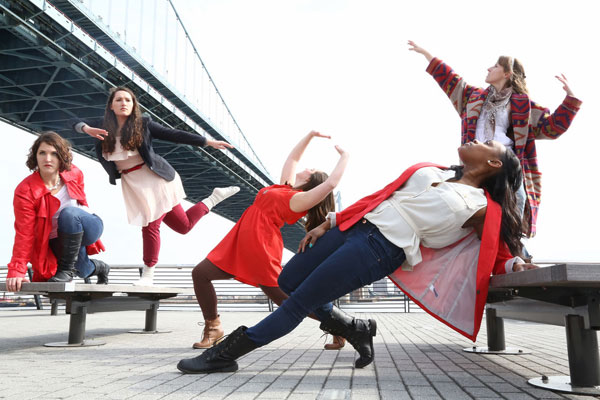National Water Dance – picture by Bill Herbert
left to right: Emma MacDonald, Zoe Norris, Julee Mahon, Tiffany Williams, and Heather Dyer
In a city as diverse as Philadelphia, art serves as a constant dialogue between our communities. Where words don’t dare trespass, the production of art emerges as a visual manifestation of our social conscience. It is because of art’s ability to transcend and strengthen ties of ‘Brotherly Love’ that artists share a very special status within the many layers of our city. Their ability to transcribe the feelings and emotions of their surroundings, which often lay hidden deep down in the rest of us by formalities and agenda, gives their words a special resonance that reaches across barriers.
It is that ability to bridge divides that provided me with a fitting metaphor for my interview with Colleen Hooper. A 3rd year dance Ph.D. student at Temple University, Hooper was the choreographer for the local performance of the National Water Dance on the Race Street Pier, which was part of a national movement to bring attention to the fragility of our waterways. The show took place on April 12 and was a collaboration between students, faculty and alumni from Temple University. As they were performing, dancers from 69 other institutions danced next to bodies of water in 28 states.
The first water dance took place in Miami, Florida, in 2011, but this was the first time the Race Street Peer has served as a site. As choreographer of Philly’s tributary in the collaboration, it was up to Hooper to show, through dance, that we are all one on this issue. The fundamental tenet of life is that we need water to survive. Nevertheless, as active spectators of art and activism, it is ultimately up to us to make those associations between life and death in a collaborative dance performance.
Just how might a dancer demonstrate the impact of pollution, drought, or water’s overuse on our communities? Choreographer Colleen Hooper provided some good insights into the performance, and how Philadelphia played a strong supporting role in the piece.
Marc Londo: As choreographer, what informed your perspective of the dance?
Colleen Hooper: While this dance was part of a larger national project dedicated to water conservation and building water ethic, my personal ideas for this piece dealt with the water within our bodies and how water changes state from liquid to solid to gas. Because our bodies are primarily composed of water, I worked with the dancers to find movement that helped us feel the sensation of water within our bodies. We also experimented with movements that related to water flowing, ice cracking, and vapor diffusing into the air. We experimented with our connection to water.
ML: How long did you rehearse for this event?
CH: The rehearsal process was two months long.
ML: As the choreographer, what considerations factor into designing a dance program that focuses on the relationships we have to our environment?
CH: Because my medium is dance, I immediately think about how our bodies connect to the environment. By focusing on the water within our bodies, it becomes clear that taking care of our waterways is essential to our survival as a species. We are water, and by eliminating the perception of being separate from water, the dancers embodied water in its various states of matter.
ML: Was there a unique piece to the performance that highlighted Philadelphia’s place on the east coast?
CH: The surroundings really tell the story of our city as a historical port destination. With the backdrop of the Ben Franklin Bridge, the Campbell’s soup factory in Camden, recreational and industrial boats, and the adjacent warehouse pier, we were physically moving in a rich tapestry of our city’s industrial and tourist identity.
ML: As a dancer, how can one emote the severity of an issue like the fragility of our waters?
CH: We worked on feeling the water in our bodies and connecting to our environment. Each dancer who performed had personal reasons why she was interested in this issue, so I encouraged each individual to let these feelings come through in the performance.
We also performed a three-minute finale phrase that was choreographed with movement from a number of the participants from all over the country. The National Water Dance director, Dale Andree, collected movements from all of the participants via the project’s website and then Andree choreographed these movements into a three minute phrase. By dancing a phrase created collectively by a large group, we emotionally connected to the nationwide project.
ML: When choreographing a dance on the Race Street Pier, what considerations must you be mindful of to make the show visually engaging with the audience?
CH: I wanted to move through different sections of the pier so that the audience had a chance to enjoy the dance from a variety of perspectives. It was important for me to avoid turning the pier into a typical theatrical stage with one strongly indicated front facing.
ML: What can we, as Philadelphians, do to ensure that our waters aren’t damaged beyond the point of no return?
CH: On our performance program, we listed local organizations that promote cleaner water and urged audience members to consider supporting these groups. I know there have been a number of rain barrel workshops throughout the city that help people collect water for irrigation and outdoor washing. This helps with conservation- other ways to conserve water include taking shorter showers and using less water with household cleaning and chores. I also think that raising awareness about dumping in storm drains can make a huge difference. Many people in the city don’t realize that everything they dump into our storm drains goes directly into our water supply. By talking to our neighbors about this, cleaning trash out of our storm drains, and applying stickers that explain where this water goes, people can help protect our water. Get Involved!
To learn more about Colleen Hooper and the National Water Dance Festival in Philadelphia visit www.colleenhooper.com/ and www.temple-news.com/lifestyle/dances-water/.


 Gaming7 years ago
Gaming7 years ago
 Music7 years ago
Music7 years ago
 Business7 years ago
Business7 years ago
 The Jawn7 years ago
The Jawn7 years ago
 The Jawn7 years ago
The Jawn7 years ago
 The MC7 years ago
The MC7 years ago
 Entertainment7 years ago
Entertainment7 years ago
 The Jawn7 years ago
The Jawn7 years ago








You must be logged in to post a comment Login